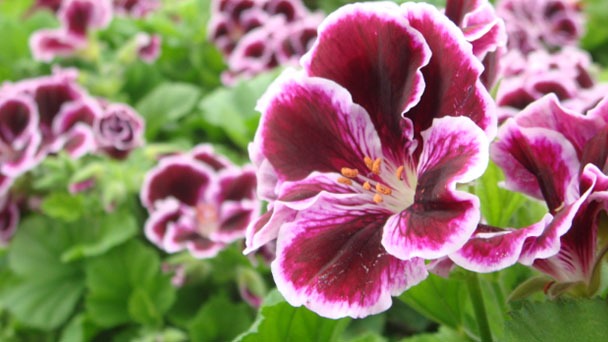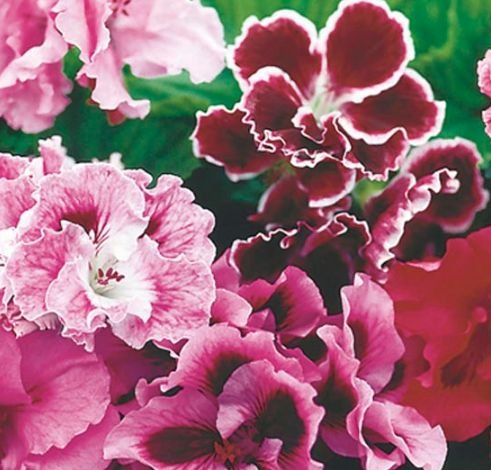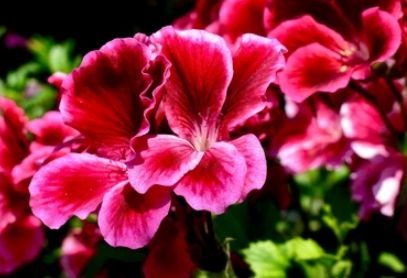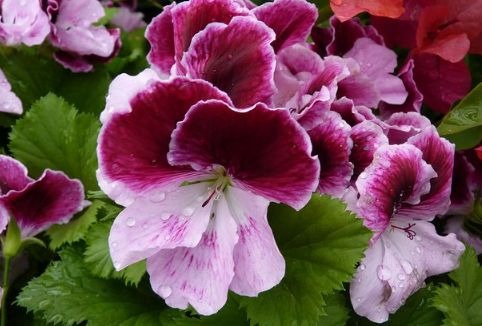Martha Washington Geranium - The Complete Caring Guide
Written by Ivy
Jan 07 2023

The care of geraniums cannot be learned in a masterclass. The most popular species of this genus all produce vibrant blooms and have compact, densely-green foliage that fits inside a hanging basket. The Martha Washington Geranium is an assertive variety with velvet petals that does reasonably well in cold, crisp weather.
Martha Washington Geranium Care

Light and Temperature
The Martha Washington geranium needs lots of exposure to the sun. Yet you ought to stay out of the sun.
The most important requirement is to guarantee that the regal geranium receives at least six hours of direct sunlight each day. The foliage will begin to droop and wilt if it doesn't receive enough light.
Keep the temperature between 50 and 60 degrees Fahrenheit in the winter and in the low to middle 70s in the summer.
However, take care not to completely rob it of natural light as the leaves will start to droop and wilt. The Martha Washington plant, like the majority of its relatives, thrives in conditions where the ambient temperature doesn't rise above 16 degrees Celsius.
Watering and Feeding
Throughout the growing season, regal geraniums need to be watered frequently.
Plants in the summer may require watering several times per week.
You might only need to water the plant once every one or two weeks when it goes dormant in the winter.
If you want to grow big blooms and foliage during the summer, liquid fertilizer is advised twice a month.
Avoid using high-nitrogen fertilizers because they will promote growth rather than blooms.
However, this fast-growing plant doesn't really require much encouragement to grow.
Soil and Transplanting
The Martha Washington geranium thrives in well-drained soil. It is preferable to use regular potting soil.
Repotting a large geranium is not always simple. The best course of action is to take cuttings and propagate the plant.
If you do need to transplant a mature geranium, you should do so right before summer, before the plant starts growing quickly.
Additionally, you ought to prune it and take out any cuttings that can be used for further growth.
Grooming and Maintenance
It is advised to groom plants because it helps them live longer. As blossoms rot, removing spent flowers encourages the growth of new flowers and helps to combat disease.
For more read our article on Deadheading Geraniums
Even though they can live for years, regal geraniums usually reach their peak after three.
Indoor geraniums eventually need to be pruned back as they enlarge and take on an open, unformed appearance.
Additionally, the weaker, spindlier top shoots and smaller flowers start to appear.
This "look" means it is time to prune the plant. The plant will resume its full flowering, develop new shoots, and take on a bushier shape.
How to Propagate Martha Washington Geraniums
To propagate Martha Washington geraniums, trim the plants back and use all the "not too woody" tip cuttings.
Cuttings with one or two pairs of leaves on a four-inch tip will root the best.
- Place cuttings in water or dip the bottoms into a hormone rooting powder
- Pot cuttings in a well-draining sandy soil
- Cover pots with plastic bags (include some air holes)
- Cuttings should take root within two to three weeks
- Once rooted plant cuttting in a new pot

How to Make Your Martha Washington Geranium Re-Bloom
- Cut it back. Cut back plant to 4-inch (10-cm) stems in the summer after flowering has finished.
- Repot. Repot your plant once the flowers have faded, just to give it new soil. You can continue to grow the geranium in the same pot because it blooms best when slightly pot-bound. Geraniums do not like having their feet wet, so just make sure it has drainage holes to prevent overwatering.
- Give it a rest. Give the plant time to rest this summer. During this period of rest, water sparingly and stop fertilizing. Keep it in filtered light.
- Cool it off. Allow your Martha Washington geranium two months of cool weather so that the flower buds will develop. For the "cooling off" period, move your plant outside in fall when the nighttime temperature drops to 50°F/10°C. Alternatively, you could store it in a cool basement or garage where it will receive plenty of indirect light. While receiving this cool treatment, resume regular watering and fertilizing.
The above steps should result in the appearance of flower buds in the middle of winter and stunning blooms in either February or March.
Martha Washington Geranium Pests Or Disease Problems
Yellow Leaves – Plants start to display yellow leaves and brown spots when the soil is too dry.
Remedy – Water the soil deeply and keep an eye on its moisture.
Weak Growth – this usually shows up when plants do not get enough light.
Remedy – Change the plant's location to one that receives more light. Ensure that the plant receives shade.
Weak Basal Shoots – The presence of bacteria can weaken plants.
Remedy – The best course of action is to discard the plant. DO NOT take cuttings from the plants.
Fungus And Rotting Stems – Plants may develop fungus and their stems may start to rot when they are kept in dark, damp areas.
Remedy – DO NOT take cuttings from the plants; instead, dispose of them.
"Balls Of Cotton" – When plants have white "balls of cotton" on leaves and stem axils expect to find mealybugs.
Remedy – Neem oil or insecticidal soap can be used to treat mealy bugs.
There are many leaves but few flowers. fertilizer for geraniums in excess High nitrogen fertilizer is being fed to plants in excess.
Solution: Cut back on fertilizer. Starve the plants a little bit.
How Big Do Martha Washington Geraniums Get?
The Martha Washington geranium has the potential to get very big. It can grow up to two feet in just a single year.
The plants are primarily an indoor plant, though you can grow these regal geraniums outdoors.
These geraniums produce fewer flowers and typically only flower once when grown outdoors.
They favor soil with good drainage. Sandier soil should be used when a plant is young. A mature Martha Washinton flower, however, thrives in regular potting soil.
The USDA hardiness zones for these plants range from 5 to 10, but cooler climates tend to have longer blooming times.
If you decide to grow the regal geranium outdoors in a garden bed, space the plants at least 8" to 12" inches apart. When growing in a pot, the pot should have a minimum diameter of eight inches.
Keep drainage in mind. To prevent the soil from staying too wet, the pot needs drainage holes.
How to Overwinter Geraniums
Your plant will eventually die if it receives too much frost during the winter, especially if it is growing outdoors. And since you don't want to lose such a lavish flowering plant, you can do something to help it survive the winter so that it can bloom more vibrant flowers in the spring.
Geraniums are remarkable in that they can survive the winter without soil, making them suitable for dormant storage. Because they have stems that resemble succulents, unlike many other annual plants, they can extend their dry period. To prepare your houseplants for this season, you need to:
- Shake the soil from the roots of your geraniums after removing them from their growing medium.
- To provide the roots with moisture over the winter, leave some soil on them.
- Remove any dead leaves, especially those that appear brown because they could be diseased and pose a threat to the plant's health. Cut off any stems that appear hollow or show any rotting symptoms as well.
- Even if they are still in bloom, remove the flowers as well.
- Your geraniums should be placed inside a paper bag upside-down.
- The ideal room temperature for the paper bag is between 55 and 60 degrees Fahrenheit. Place the bag in a cool, dark area.
- To make sure your geraniums aren't drying out or becoming moldy, check them at least twice a month.
- Any leaves exhibiting early signs of fungus, which results in the decay of a portion of the plant, should be removed.

Conclusion
Watering Martha Washington Geraniums requires a little different attention than other geraniums do. Because they grow in fertile, well-draining soil, these geraniums need to be checked frequently and kept moderately moist. Make sure they don't remain wet or sit in drip trays with standing water, though.
Use a water soluble fertilizer with a higher phosphorus content to fertilize Martha Washington geraniums on a weekly basis. In the fertilizer number sequence, phosphorus is the middle number. Such combinations include 15-30-15. Avoid using even numbers, such as 20-20-20, which has a little more nitrogen (the first number) and will encourage more green leafy growth than blooming.
Martha Washington geraniums benefit from deadheading, which is the removal of outdated flower heads, to maintain an active blooming state. Because it may prevent flowers from blooming, avoid pinching or pruning the plants.
Latest Updated
- Benefits of Bugleweed - 7 Science-backed Health Benefits
- Bugleweed Dangers & Side Effects - Is It Poisonous?
- How to Plant Evergreen Trees - What You Should Know
- When to Plant Evergreens - Grow Guide for Evergreen Trees
- 12 Wonderful Evergreen Shrubs for Your Garden
- 12 Popular Evergreen Plants with Pictures for Beginners
- When And How To Prune A Lilac Bush Like a Pro
- How to Grow & Care for Lilac Vine (Hardenbergia Violacea)
- Japanese Lilac Tree (Syringa Reticulata) Care & Propagation Guide
- Shumard Oak Pros and Cons - What to Know
Popular Articles
- Winter maintenance of Antirrhinum Majus
- How to Grow Terminalia Mantaly Tree
- How to Grow and Care for Crossostephium Chinense
- How to grow Antirrhinum Majus in spring
- Peristeria Elata (Dove Orchid) Profile: Info & Care Guide
- Underwatered Snake Plant (Sansevieria Trifasciata) - Signs And How To Fix
- How to Care for Brazilian Jasmine Plant (Mandevilla Sanderi)
- How to Grow & Care for Graptopetalum Purple Delight in Summer
- Rosa Chinensis (China Rose): Plant Growing & Care Tips
- How to Care for Baby Sun Rose (Aptenia Cordifolia)